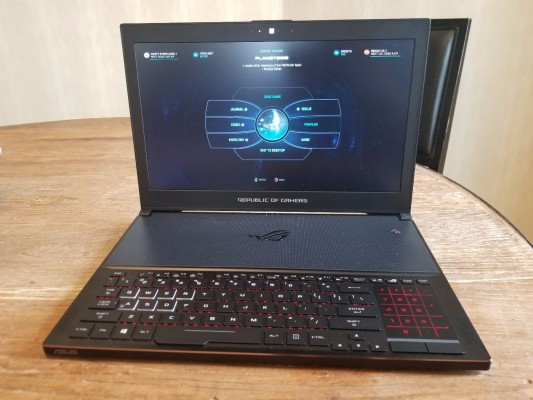Nvidia’s Max-Q Will Make Your Gaming Laptops Incredibly Slim
Most gaming laptops are bulky beasts, but soon that may no longer be the case. Today at its press conference at Computex, Nvidia announced its new design approach, Max-Q, which is meant to make gaming laptops thinner, faster and quieter. You’ll be able to find Max-Q designed laptops with Nvidia’s GeForce GTX 1080, 1070 and 1060 GPUs from major vendors starting on June 27th.
The goal was to make gaming notebooks that are up to 3 times thinner with 3 times more performance than existing laptops. Now, they can be as slim as 0.7-inches, Nvidia says, with up to 70 percent more performance than before. These laptops will come from manufacturers including Acer, Alienware, Asus, Clevo, Gigabyte, HP, Lenovo, Maingear, MSI, Origin and more. This is all still based on Nvidia’s Pascal architecture, also known as the 10-series GPUs. But now, it’s all precision engineered from the laptop down to the electrical components to make sure everything is as efficient as possible.
MORE: Which GPU is Right For You?
Those optimizations include low-voltage clock curves for cards like the GTX 1080 to squeeze out performance while reducing power; better Game Ready drivers to increase efficiency and thermal solutions for laptops to keep them cooler, allowing for higher gaming performance. Gaming laptops designed for Max-Q are are ready for anything GeForce related from G-Sync screens to VR and 4K gaming.
Earlier, Nvidia showed us some laptops from MSI, Clevo and Asus that used Max-Q, and I was wowed by just how thin these notebooks were. They still maintained all of the ports I expected and played games like Tekken 7, Mass Effect Andromeda at Overwatch at high frame rates with crisp graphics. We can’t wait to test them when they show up.
Additionally, Nvidia announced its new WhisperMode tech, which lets laptops run more quietly while playing games. It configures graphics settings and frame rates to favor power efficiency, which should make laptops, well, whisper quiet. All Pascal-based laptops will get this update soon via a software update in GeForce Experience.
Photos: Andrew E. Freedman / Laptop Mag
Sign up to receive The Snapshot, a free special dispatch from Laptop Mag, in your inbox.
Laptop Guide
- Laptop Buying Guide: 8 Essential Tips
- The Best & Worst Laptop Brands
- Laptop Tech Support Showdown: Undercover Report
- Should I Buy a Chromebook? Buying Guide and Advice
- Laptops with the Longest Battery Life
- Chromebooks vs. Windows 10 Laptops: What Should You Buy?
- Why You Shouldn't Buy a Touch-Screen Laptop
- Out of the Box Tips: Set Up Your New Laptop Like a Pro
- The Best Time to Buy a Laptop
- Chromebook vs. Tablet: Which Should You Buy?
- Laptop Buying Tips for Students
- 10 Key Features to Look for in Your Laptop
- How to Buy a 2-in-1 Laptop Hybrid
- USB Type-C FAQ: Everything You Need to Know
- How to Get Rid of Your Old Laptop
- Laptop Warranties: What They Cover
- Which CPU is Right For You?
- Which Laptop Features Are Worth the Money?
- Gaming Laptop Buying Guide: Find the Right Rig
- 10 Reasons Why Consumers Should Buy Business Laptops
- Which MacBook is Right for You?
- 5 Things to Look For in Your Next Laptop Keyboard
- How to Configure Your Laptop: Specs That Matter
- Which Graphics Card Do You Need?
- The Perfect Laptop? Here’s What It Should Have
- Why 78 Percent of Laptop Screens Suck
- A Guide to Computer Ports and Adapters
- 13 Ways to Make a Slow Laptop Faster
- How to Tell If You Can Upgrade Your Laptop
- Laptop Locks Guide: Do You Need One?
- 10 Features You Can Skip to Save Money
Andrew is a contributing writer at Laptop Mag. His main focus lies in helpful how-to guides and laptop reviews, including Asus, Microsoft Surface, Samsung Chromebook, and Dell. He has also dabbled in peripherals, including webcams and docking stations. His work has also appeared in Tom's Hardware, Tom's Guide, PCMag, Kotaku, and Complex. He fondly remembers his first computer: a Gateway that still lives in a spare room in his parents' home, albeit without an internet connection. When he’s not writing about tech, you can find him playing video games, checking social media and waiting for the next Marvel movie.



